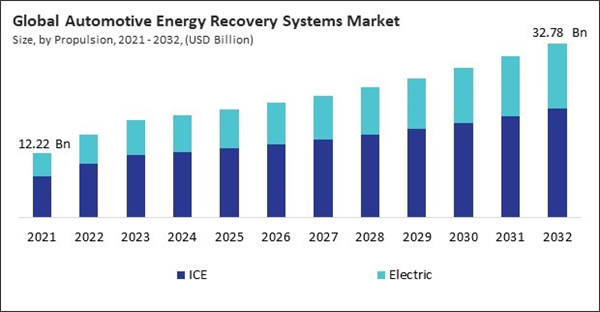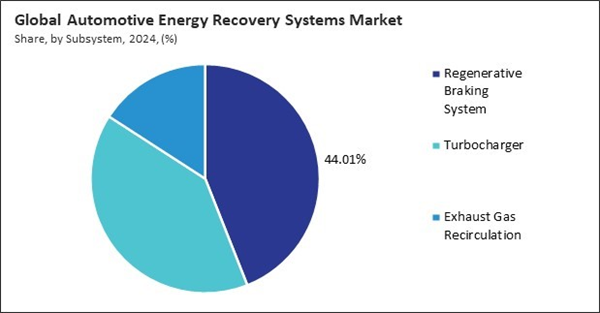Governments’ emphasis on emission regulations has further encouraged automakers to incorporate such recovery systems in ICE vehicles. Additionally, the large global fleet of existing ICE vehicles continues to drive demand for aftermarket energy recovery components and technologies, sustaining the segment's market strength.
COVID-19 Impact Analysis
The COVID-19 pandemic significantly disrupted global supply chains, causing delays in the manufacturing and delivery of automotive components, including those used in energy recovery systems. Lockdowns and movement restrictions forced the temporary shutdown of numerous automotive production facilities worldwide. This disruption led to reduced production volumes and delayed launches of energy-efficient vehicle models that incorporated advanced recovery technologies such as regenerative braking and turbochargers. Thus, the COVID-19 pandemic had a negative impact on the market.Driving and Restraining Factors
Drivers
- Stringent Environmental Regulations and Emission Standards
- Rising Consumer Demand for Fuel-Efficient Vehicles
- Technological Advancements in Energy Recovery Systems
- Growth in Electric and Hybrid Vehicle Adoption
Restraints
- High Initial Development and Implementation Costs
- Limited Infrastructure for Supporting Advanced AERS Technologies
- Consumer Skepticism and Lack of Awareness
Opportunities
- Integration with Autonomous Vehicle Technologies
- Expansion of Aftermarket AERS Solutions
- Integration with Smart City Ecosystems
Challenges
- Technological Complexity in Scaling AERS for Diverse Vehicle Types
- Market Fragmentation Due to Regional Variations
- Supply Chain Disruptions for Critical Components
Market Growth Factors
The global push for stringent environmental regulations and emission standards is a primary driver for this market, as governments worldwide enforce policies to reduce greenhouse gas emissions and combat climate change. Regulatory bodies, such as the Environmental Protection Agency (EPA) in the United States and the European Union’s emissions framework, have set ambitious targets for reducing vehicle-related carbon dioxide (CO₂) and nitrogen oxide (NOx) emissions. Therefore, stringent environmental regulations and emission standards drive the market by compelling automakers to adopt energy recovery technologies to meet global compliance requirements and reduce emissions.The growing consumer demand for fuel-efficient vehicles is a significant driver for this market, as buyers increasingly prioritize cost savings and environmental sustainability. With fuel prices rising globally - often by 4% to 9% annually - consumers are seeking vehicles that offer better mileage and lower operating costs. AERS, such as regenerative braking systems and turbochargers, improve fuel efficiency by capturing and reusing energy that would otherwise be lost during braking or exhaust processes. In conclusion, rising consumer demand for fuel-efficient vehicles drives the market by encouraging automakers to integrate energy recovery technologies that reduce costs and appeal to eco-conscious buyers.
Market Restraining Factors
The high initial development and implementation costs of Automotive Energy Recovery Systems represent a significant restraint on market growth, as these expenses create financial barriers for automakers and consumers alike. Developing advanced AERS, such as regenerative braking systems or waste heat recovery technologies, requires substantial investment in research, engineering, and testing to ensure reliability and efficiency. Thus, high initial development and implementation costs restrain the AERS market by increasing financial barriers for automakers and consumers, limiting adoption across diverse vehicle segments.Value Chain Analysis
The value chain analysis of the ERS market outlines the complete lifecycle of ERS components and systems. It begins with raw material sourcing, followed by component design and development, and then component manufacturing. These components undergo system integration and testing before being incorporated into the vehicle platform. Post integration, the process moves to final vehicle manufacturing and assembly, followed by distribution, sales, and marketing. Once the vehicle is in use, after-sales service and diagnostics play a crucial role. Finally, recycling and circular economy practices feed materials back into the chain, promoting sustainability and resource efficiency.
Propulsion Outlook
Based on propulsion, the automotive energy recovery systems market is characterized into ICE and electric. The electric segment procured 36% revenue share in the automotive energy recovery systems market in 2024. The growth of this segment is closely tied to the accelerating global adoption of electric vehicles (EVs), supported by strong government incentives, infrastructure development, and rising consumer awareness regarding sustainability. Electric vehicles heavily rely on regenerative braking systems to recapture kinetic energy during deceleration and feed it back into the battery, enhancing overall energy efficiency.Subsystem Outlook
On the basis of subsystem, the automotive energy recovery systems market is classified into regenerative braking system, turbocharger, and exhaust gas recirculation. The turbocharger segment recorded 40% revenue share in the automotive energy recovery systems market in 2024. Turbochargers are widely used in internal combustion engines to improve fuel efficiency and engine performance by utilizing exhaust gases to increase air intake pressure. With growing regulatory pressure to reduce emissions and improve fuel economy, automakers are increasingly adopting turbocharging technology in gasoline and diesel engines.Vehicle Outlook
By vehicle, the automotive energy recovery systems market is divided into passenger cars, light commercial vehicles, and heavy commercial vehicles. The light commercial vehicles segment procured 24% revenue share in the automotive energy recovery systems market in 2024. LCVs, widely used for urban deliveries and logistics, are increasingly adopting energy-efficient technologies to meet rising fuel economy standards and lower operating costs. As last-mile delivery services expand - especially with the growth of e-commerce - automakers are integrating energy recovery systems like turbochargers and regenerative braking to improve vehicle performance and sustainability.Regional Outlook
Region-wise, the automotive energy recovery systems market is analyzed across North America, Europe, Asia Pacific, and LAMEA. The Asia Pacific segment recorded 44% revenue share in the market in 2024. This growth is fuelled by the presence of major automotive manufacturing hubs such as China, Japan, South Korea, and India. The rapid expansion of vehicle production, coupled with increasing environmental regulations and government incentives for fuel-efficient and electric vehicles, has accelerated the integration of energy recovery technologies in the region.List of Key Companies Profiled
- Robert Bosch GmbH
- Denso Corporation
- Continental AG
- ZF Friedrichshafen AG
- Valeo SA
- Eaton Corporation plc
- Hyundai Motor Company
- Mitsubishi Electric Corporation
- Maxwell Technologies
- Schaeffler AG
Market Report Segmentation
By Propulsion
- ICE
- Electric
By Subsystem
- Regenerative Braking System
- Turbocharger
- Exhaust Gas Recirculation
By Vehicle
- Passenger Cars
- Light Commercial Vehicles
- Heavy Commercial Vehicles
By Geography
- North America
- US
- Canada
- Mexico
- Rest of North America
- Europe
- Germany
- UK
- France
- Russia
- Spain
- Italy
- Rest of Europe
- Asia Pacific
- China
- Japan
- India
- South Korea
- Singapore
- Malaysia
- Rest of Asia Pacific
- LAMEA
- Brazil
- Argentina
- UAE
- Saudi Arabia
- South Africa
- Nigeria
- Rest of LAMEA
Table of Contents
Companies Mentioned
- Robert Bosch GmbH
- Denso Corporation
- Continental AG
- ZF Friedrichshafen AG
- Valeo SA
- Eaton Corporation plc
- Hyundai Motor Company
- Mitsubishi Electric Corporation
- Maxwell Technologies
- Schaeffler AG











